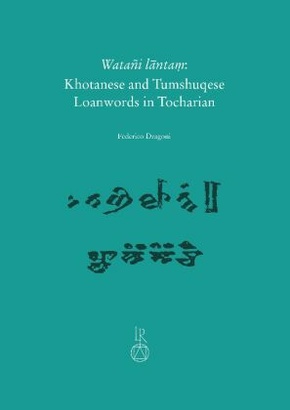
Watañi lanta_ - Khotanese and Tumshuqese Loanwords in Tocharian
| Verlag | Reichert |
| Auflage | 2023 |
| Seiten | 332 |
| Format | 17,8 x 2,6 x 25,8 cm |
| Gewicht | 715 g |
| Artikeltyp | Englisches Buch |
| Reihe | Beiträge zur Iranistik 50 |
| ISBN-10 | 3752006900 |
| EAN | 9783752006902 |
| Bestell-Nr | 75200690A |
Contacts between Tocharian A and B and Khotanese and Tumshuqese, four languages once spoken in today's Xinjiang Uyghur Autonomous Region in Northwest China, lack a comprehensive treatment and are still a controversial topic. This work contains the first systematic investigation of the matter from a linguistic point of view. Through a detailed analysis of the lexical material, the author is able to argue that the influence of Khotanese and Tumshuqese on Tocharian was much more extensive than previously thought and it spanned over almost two millennia, from the early Iron Age until the extinction of the four languages at the end of the first millennium CE.
1. Preis der Indogermanischen Gesellschaft für die beste Dissertation (2022);
Award of Iranian Studies of the Societas Iranologica Europaea (2023)
This work contains the first systematic investigation of the linguistic contacts between Tocharian A and B and Khotanese and Tumshuqese, four languages once spoken in the Tarim Basin, in today's Xinjiang Uyghur Autonomous Region in Northwest China. The main part of the book is devoted to determining a corpus of reliable Khotanese and Tumshuqese loanwords in Tocharian: new borrowing etymologies are proposed, and some old correspondences are rejected. The discussion of the individual loanwords often involves a fresh examination of the text passages where they occur, and, in some cases, it offers lexical insights regarding a variety of neighbouring languages (Chinese, Middle Persian, Parthian, Sogdian, Gandhari and Old Uyghur). A detailed phonological, morphological, and semantic analysis of the corpus follows, with a view to determine the phonological correspondences, the relative chronology of the loanwords and possible historical scenarios of cultural exchange. One of the results of this investigation is that the influence of Khotanese and Tumshuqese on Tocharian was much more extensive than previously thought and it spanned over almost two millennia, from the early Iron Age until the extinction of the four languages at the end of the first millennium CE.
